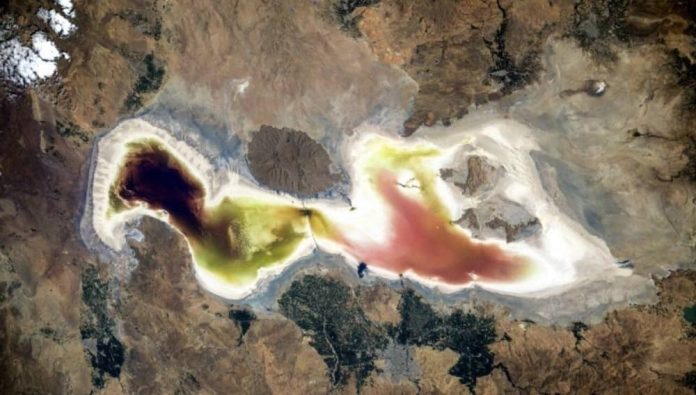Iranian State-run Newspaper Announces Urmia Lake As Dead

iran urmia lake (1)
Written by
Amir Taghati
Lake Urmia, once a vast expanse of 878 square kilometers, is now on the brink of ecological collapse, retaining only 4% of its former water volume, as reported by the state-run daily Etemad on November 23. Recent satellite imagery comparing the lake’s surface area over the past year reveals an alarming 80% reduction, shrinking to a mere 170 square kilometers. This drastic transformation signifies a dire state, positioning Lake Urmia as the world’s sixth-largest saltwater lake on the verge of extinction and the largest inland lake in Iran.
Contrary to official statements asserting the stability of Lake Urmia’s water levels, the evidence suggests otherwise. The impact of ongoing efforts, such as the Lake Urmia Restoration Taskforce initiated in 2013, has shown temporary improvement, with the lake’s water surface expanding to 3,102 square kilometers in 2019. However, subsequent years witnessed a continuous decline, with the lake’s surface area plummeting to less than 880 square kilometers by 2022.
Recent images that indicate the demise of Lake Urmia have been released at a time when, on September 12, Firuz Ghasemzadeh, the spokesperson for the regime’s water industry claimed, “Lake Urmia has not dried up, and the rumors circulating about the complete drying of Lake Urmia are unfounded.”
#Iran: Lake Urmia (Sixth-Largest Saltwater Lake on Earth) Is in Danger. https://t.co/VkD55DiwM2 pic.twitter.com/4zTrTKwXIi
— NCRI-FAC (@iran_policy) March 15, 2017
According to the latest report from the Remote Sensing Research Center of the Sharif University of Technology, titled “Analysis of the Elevation, Surface, and Volume of Lake Urmia Using Satellite Images,” published in November, changes in the water level of Lake Urmia from 2015 to 2023 have been investigated using LANDSAT satellite imagery.
The ramifications extend beyond Lake Urmia, as other bodies of water across the nation, such as Shadegan, Hoorolazim, Bakhtegan, Hamoun-e Jazmourian, Ghavkhouni, and numerous others, grapple with similar challenges. However, what distinguishes Lake Urmia is its vast expanse, equivalent to the size of Alborz Province, and the transformation of its dried bed into a colossal dust-producing center in the northwest. The salinity of the desiccated lakebed exacerbates health, industrial, social, and economic consequences induced by dust storms, making it an unparalleled priority for immediate attention and intervention.
In light of these environmental crises, a closer examination reveals a troubling political angle. Through its shortsighted, monetary-driven, destructive policies, the Islamic Revolutionary Guard Corps (IRGC) has been implicated in exacerbating the depletion of Iran’s water resources.
#Iran News in Brief
Following reports of Lake Urmia drying up due to the clerical regime’s policies, Ramezan Sharif, #IRGCterrorists spox, attempted to rationalize the situation, claiming that similar lake dry-ups have occurred globally over the past 800 years, indicating that… pic.twitter.com/pw2vMKq0Kt— NCRI-FAC (@iran_policy) August 10, 2023
The IRGC has constructed numerous dams on rivers that flow into Lake Urmia, diverting water away from the lake and contributing to its shrinkage. The IRGC, through its extensive agricultural holdings, has promoted water-intensive farming practices in the region, further depleting the lake’s water resources. The IRGC’s dominance over Iranian environmental agencies has hindered effective efforts to protect Lake Urmia and address the factors contributing to its desiccation.
It is crucial to act urgently, as the future of Lake Urmia teeters on the edge. This situation represents more than just an environmental tragedy; it’s a complex crisis that requires immediate attention and resolution. Over the past four decades, the people of Iran have come to understand that as long as the clerical dictatorship remains in control, they will face deprivation not only in terms of socio-political freedoms and economic opportunities but also in terms of a healthy life.

